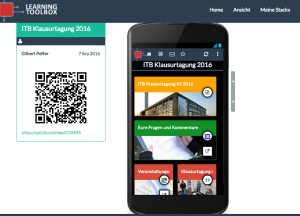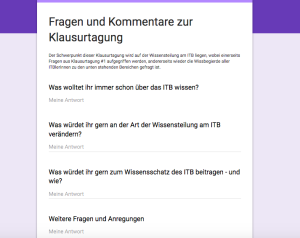Learning Layers in Leeds – Part Two: Giving a picture on construction pilot and Learning Toolbox
Last week our EU-funded Learning Layers (LL) project had its last joint project consortium meeting (before the final review meeting) in Leeds, hosted by the local partners. We focused on harvesting the most recent results and coordinating the final preparatory processes for the final reporting. In the first post I will give a brief overview on the meeting on the whole. In this second post I will focus on the picture that I/we gave on the construction sector pilot in the preparation sessions and in the Elevator pitch session.
Insights into the preparation sessions (focus on impact and cases, scenarios and research approaches)
In the preparation sessions we rotated between three topic tables (of five altogether) to prepare the marketing pitches for which we had been signed (or to listen to others’ contributions and to give feedback). My choice was to give pitches on the impact cases, ‘learning scenarios’ (or instances of change) and on research approaches. In the first topic table it was useful to share ideas between construction pilot (use of Learning Toolbox at construction site) and healthcare pilot (use of Learning Toolbox in a conference environment). As a spin-off I promised to communicate the idea of using LTB in the forthcoming European conferences on vocational education and training in 2017 (ECER 2017, ‘Crossing boundaries 2017’). I also picked the idea of using LTB in conferences as a manifestation of ‘work process knowledge’ of researchers. In the topic table of ‘learning scenarios’ we discussed the criteria, what is to be presented as ‘impact cases’ and what qualifies as ‘scenarios’ or ‘instances of change’ in terms of conceptual interpretation. In the topic table of ‘research approaches’ we also had a similar discussion regarding the presentation of research methodologies and research findings.
Presenting the construction pilot in the ‘Elevator pitch’ session (‘impact cases’, ‘work process knowledge’ and ‘accompanying research’)
The ‘Elevator pitch’ session followed the pattern of marketing events that are typical in educational technology and software development communities. Each presenter had a 20 seconds slot to announce the topic and attract the interest of audience. Then the presenter had a 3 minutes slot to present the case and to convey the message. After each presentation three persons gave feedback (including one of the two ‘critical friends’ that were invited by the organisers). Below I focus on my/our presentations on the construction pilot of the LL project.
a) The impact cases: Use of Learning Toolbox in training (the pitch of Melanie Campbell) and at a construction site (my pitch)
In her pitch Melanie Campbell presented the training centre Bau-ABC as an application partner of the project and gave insights into the impact of the project from their perspective. Her key message was that Bau-ABC had engaged itself as a ‘learning organisation’ in different phases of the project work and used the opportunity to enhance the digital literacy and multimedia competences of its staff. On the basis of successful deployment of the Learning Toolbox Bau-ABC is looking forward to a more prominent role in promoting this know-how in its initial training (for apprentices), continuing training (for construction professionals) and training partnerships (with suppliers and client companies). She emphasised the new strategic interpretation of ‘Internet as the fourth learning venue’ (“Internet als vierter Lernort”) – alongside the company employing the apprentice (Ausbildungsbetrieb), the intermediate training centre (überbetriebliche Ausbildunsstätte) and the vocational school (Berufsschule) – and the contribution of the Learning Layers project in conveying this message.
In my first pitch I presented (with the help of a short video demonstration) the impact case of using Learning Toolbox (LTB) in the management of a construction site. I used the video on Thomas Isselhard’s recent presentation (see my recent blog) as an exemplary case to show, what kind of problems can be overcome with LTB, how the traditional way of managing the processes can be supported by LTB and how different parties can be engaged as users of LTB – to achieve real-time knowledge sharing and communication. Here I positioned myself as the interpreter and let the practitioner explain the benefits, see below:
b) The ‘learning scenario’: Learning Toolbox as means to make ‘work process knowledge’ transparent in lived practice
In my second pitch – for ‘learning scenarios’ (or instances of change) – I focused on the concept ‘work process knowledge’ and how the use of Learning Toolbox (LTB) can make this concept more transparent. I looked back at the original European projects of the Work Process Knowledge network (funded by EU, 4th Framework programme of research) between 1998 and 2001. In the original studies the network analysed informal and cross-organisational learning processes as preconditions for innovation. They came up with the concept of ‘work process knowledge’ (as shared foundation of knowledge, experience and trust) based on which the organisations can successfully implement major changes. The network had collected several interesting cases in which interactive informal learning in organisations – and workers’ participation in shaping the technical and organisational changes. Yet, with their plans to develop follow-up projects they got narrowed down to more particular approaches on ‘organisational learning’ and to local and sectoral tools or instruments to promote such learning. With reference to the ‘impact cases’ on LTB I argued that the introduction of the integrative toolset has helped managers, skilled workers, trainers and apprentices to get a common overview on work processes and a shared understanding on matching activities and contributions.
c) The research approach: Transformation of ‘accompanying research’ within participative design and tool deployment processes
In my third pitch – with focus on research approaches – I invited the audience to a journey to revisit the development of the accompanying research approach of ITB during the construction pilot of the Learning Layers project. Firstly I mentioned two earlier models of accompanying research (Begleitforschung) of which ITB has rich experiences:
- Accompaniment of a regional ‘Work and Technology’ programme and its projects in 1990-1997: Focus on the attainment of policy goals regarding social shaping of work, technology, organisations and regional cooperation.
- Accompaniment of nation-wide educational innovation programme ‘New learning concepts in dual vocational education and training’ 1997-2003: Focus on the attainment of self-declared innovation goals regarding introduction of new pedagogic and curricular settings, new occupational profiles and new instructional designs.
Concerning Learning Layers, I emphasised the difference, since we were working with an open and participative co-design process (with several iterative phases and adjustments), with common search for an appropriate design concept and ways to deploy the integrative toolset. During the process the accompanying researchers worked as
- explorers (mapping workshops and initial interviews),
- facilitators of digital literacy (the early multimedia training),
- co-designers (in the shaping of the concept of Learning Toolbox),
- co-tutors (the training campaign for all Bau-ABC staff),
- facilitators of tool deployment (introduction of Learning Toolbox),
- co-evaluators (collecting feedback and reviewing the qualitative feedback).
Concerning the interaction of accompanying researchers with practitioners we tried to position ourselves as supporting partners – helping them to become owners of the innovation. This was clearly successful with the early multimedia training and with the launch of trainers’ blogs (see the video of August 2014 below). In a similar way the deployment of Learning Toolbox was a user-driven exercise in which Bau-ABC trainers set their own accents on promoting problem-oriented learning (with rich resources) or interest-based and expansive learning (with gradually increasing variety of resources). In a similar way the apprentices were guided by trainers to become owners of their own learning processes by self-organised use of learning resources via Learning Toolbox.
Concluding remarks and lessons for the final run
Regarding the feedback on my pitches, I was praised for the use of video to pass a user’s own voice and accents in the first pitch, I was criticized for not using such visuals in the two latter ones (I dropped the idea because the video could not be displayed that well to all). I was also praised for presenting coherent stories but criticized for giving too much emphasis on the history and leaving the connection between history and present date too thin. Finally, I was praised by making the users visible and emphasising them as ‘pioneers’, our role in ’empowering users’ and making transparent different ways of using innovative toolsets. Altogether, this feedback helped us to pull ourselves out of project-internal reporting and to focus on new audiences who don’t have the shared background knowledge.
– – –
I think this is enough of this exercise. At the moment we are taking further steps in preparing the final documents, making further arrangements for the final review and working with follow-up activities.
More blogs to come …


